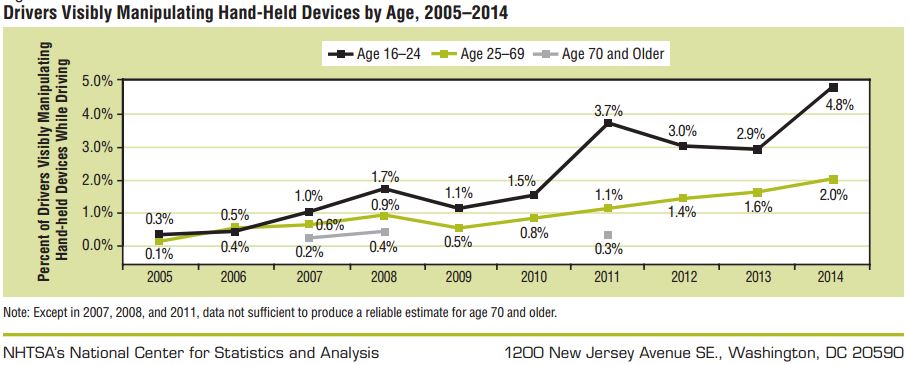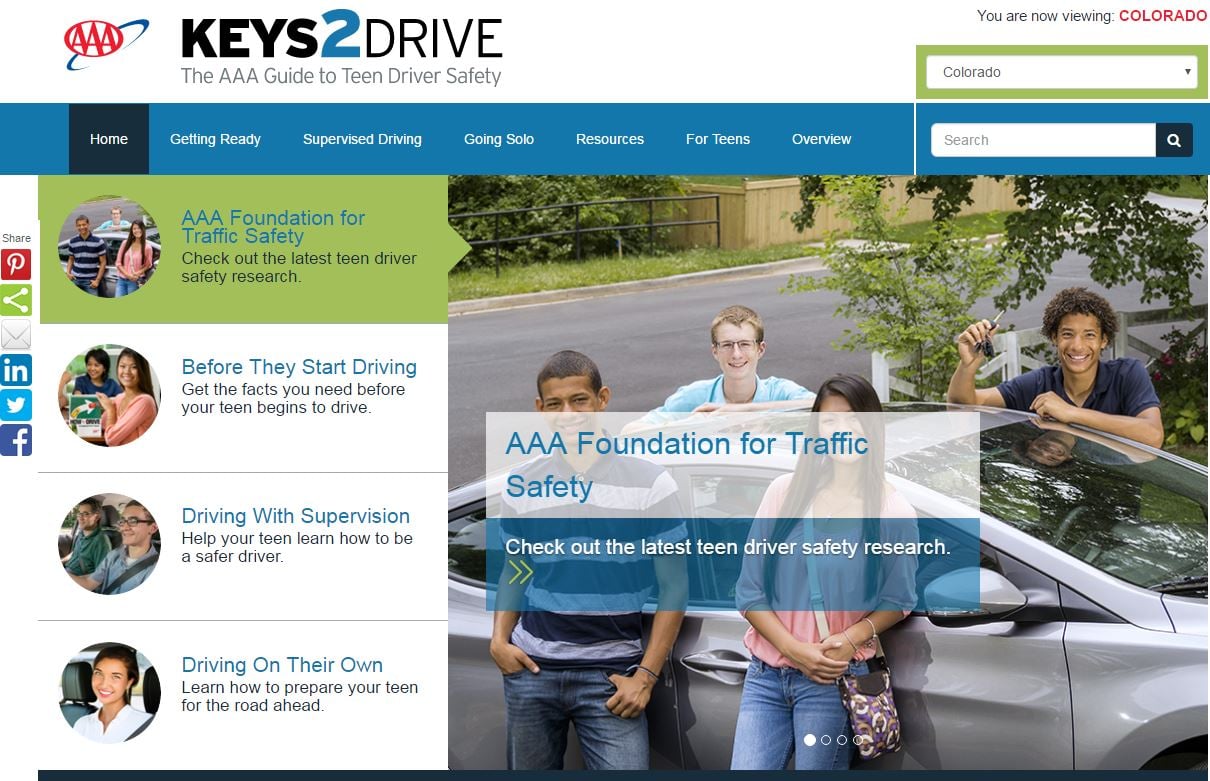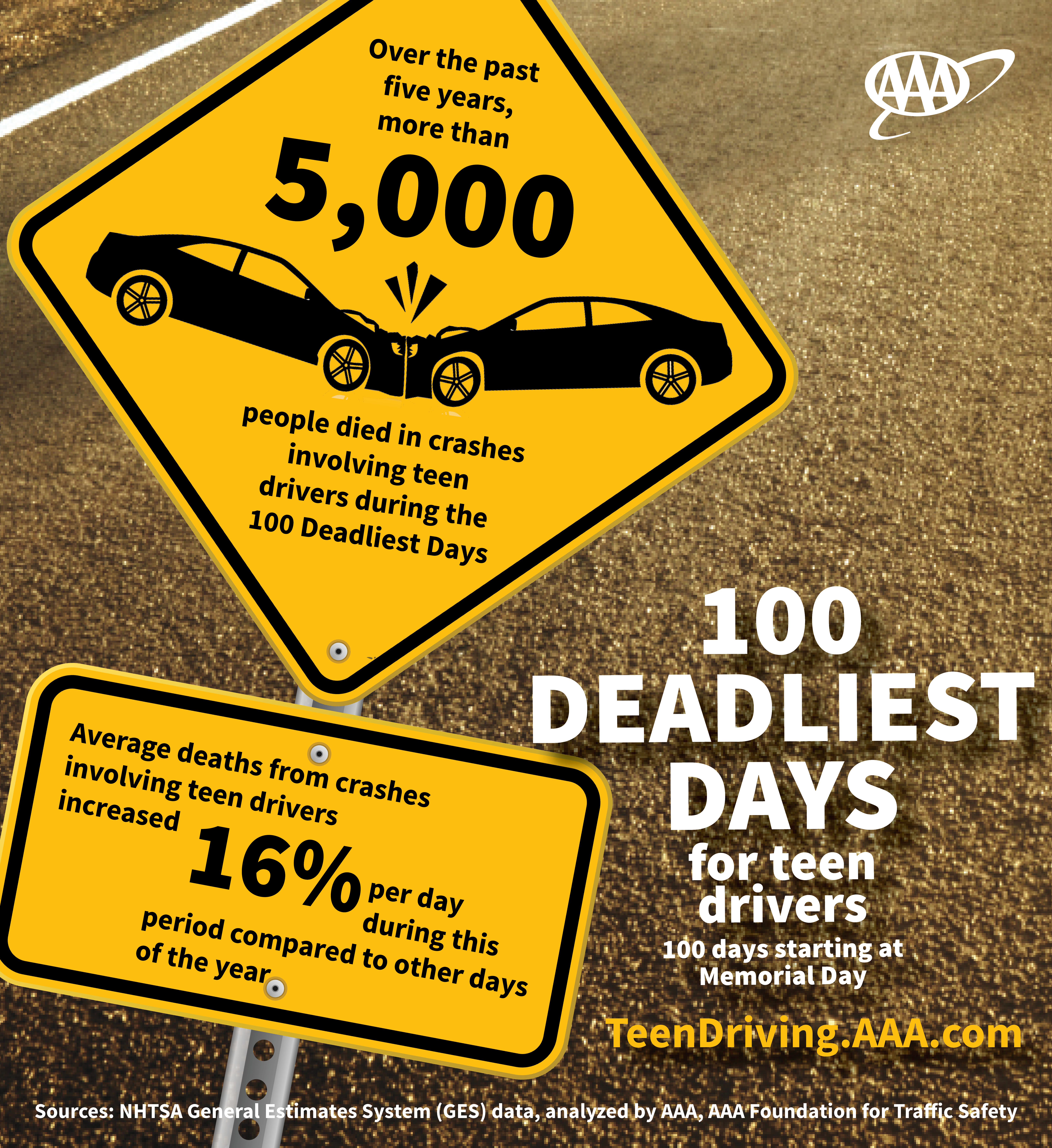Sadly, crashes for teen drivers increase significantly duringthe summer months because teens drive more during this time ofyear.
|Just in time for summer and increased teen driving, theAAA Foundation forTraffic Safety has released a study confirming that nearly 60% of teencrashes involve distractions behind the wheel.The research also finds a disturbing trend showing that texting andsocial media use are on the rise amongst teen drivers.
|“Every day during the summer driving season, an average of 10people die as a result of injuries from a crash involving a teendriver,” said Jurek Grabowski, research director for the AAAFoundation for Traffic Safety. “This new research shows thatdistraction continues to be one of the leading causes of crashesfor teen drivers. By better understanding how teens are distractedon the road, we can better prevent deaths throughout the 100Deadliest Days and the rest of the year.”
|Trends in teen driver crashes
The AAA Foundation analyzed the moments leading up to a crash inmore than 2,200 videos captured from in-car dash cameras. Thelatest report compared new crash videos with those captured from2007 -2012.
You might be surprised to learn that the No. 1 distraction forteens is not related to their cell phone use. Keep readingfor an overview of the latest AAA Foundation for Traffic Safetyfindings on trends in teen driver crashes:
||
Nearly 60% of teen crashes involve distractions behindthe wheel. (Photo: iStock)
|Top distractions
The AAA Foundation study found the following to be the topthree distractions for teens when behind the wheel in the momentsleading up to a crash:
- Talking or attending to other passengers inthe vehicle (15% of crashes).
- Talking, texting or operating a cellphone (12% of crashes).
- Attending to or looking at something insidethe vehicle: (11% of crashes).
Between 2007 and 2015 an average of 59% of crashes containedsome type of potentially distracting behavior during the sixseconds leading up to a crash.
|The latest government statistics indicate that, in 2014, 10% ofteen drivers involved in a fatal crash were reported to have beendistracted at the time of the crash. Proportionally, this is morethan any other age group.
|The AAA Foundation report notes that experts believe that thegovernment statistics substantially underestimate the prevalence ofdriver distraction. Data suggests that the true proportion ofcrashes that can be attributed to distraction and inattention islikely much higher.
|Related: 10 best and worst states for teendrivers
||
In the moments leading up to a crash, teens were more likelyto be texting or looking down at the phone than talking onit. (Photo: iStock)
|Cellphones, texting and social media
Researchers found that how teens use their cellphone when behindthe wheel changed significantly over the course of the study. Inthe moments leading up to a crash, teens were more likely to betexting or looking down at the phone than talking on it. Thissupports findings by the Pew Research Center, whichshows text messaging has become a key component in day-to-dayinteractions amongst teenagers.
“It’s no secret that teens are extremely connected to their cellphones,” said Jennifer Ryan, AAA director of state relations. “Manyteens are texting or using social media behind the wheel more oftenthan in the past, which is making an unsafe situation evenworse.”
|Research by the VirginiaTech Transportation Institute found that texting creates acrash risk 23 times worse than driving while not distracted. Arecent AAA Foundation survey shows that nearly 50% of teen driversadmitted they had read a text message or e-mail while driving inthe past 30 days. NHTSA’s National Occupant Protection Use Survey alsoshows that from 2007 to 2014, the percentage of young drivers seenvisibly manipulating a hand-held device quadrupled (see chartbelow).
||(Source: NHTSA Driver Electronic Device Use in 2014)
|Keeping cellphones out of the hands of teen drivers is a toppriority for AAA. The association’s advocacy efforts are helping toprotect teens by working to pass graduated driver licensing lawsand teen wireless bans in states across the country.
|Related: New technology prevents cell phone use whiledriving
|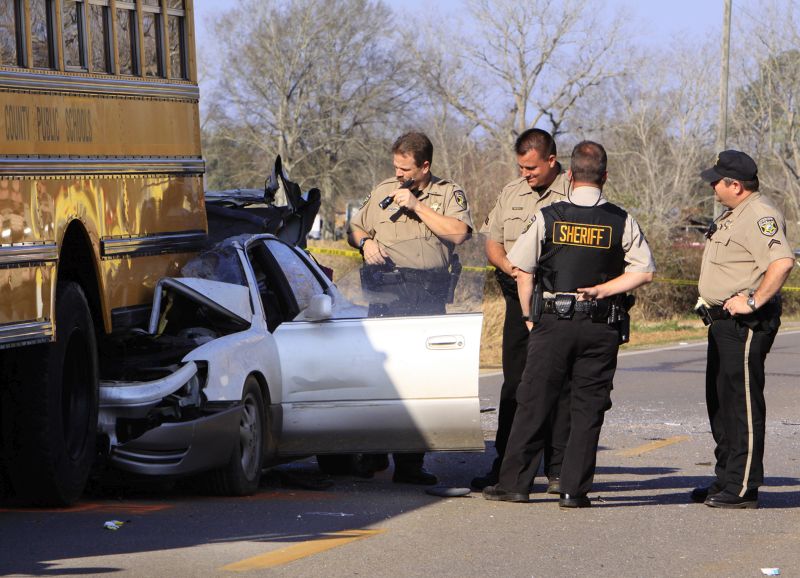
Mobile County Sheriff Deputies examine a car involved in anearly morning accident that killed 16-year-old LaDonna Perryman,who was driving on Old Pascagoula Road in Grand Bay,Alabama. (Photo: Michelle Rolls/Press-Register via APPhoto)
|Increase in rear-end crashes for teens
From 2007 to 2015, there was a significant increase in theproportion of teen driver crashes in this study that were rear-endcollisions. Rear-end crashes most often involve a driver whois following too closely and/or responding too slowly due toinattention or distraction.
While it's possible that teens have started following moreclosely, it seems more likely that distraction has led to anincrease in eyes off road time, slower reaction times andtherefore, an increase in the proportion of crashes that arerear-end crashes.
|A in-depth examination of rear-end crashes showed there was asignificant increase in the proportion of crashes in which thedriver was operating/looking at a cellphone, from 15.3% in 2008 to27.9% in 2014.
|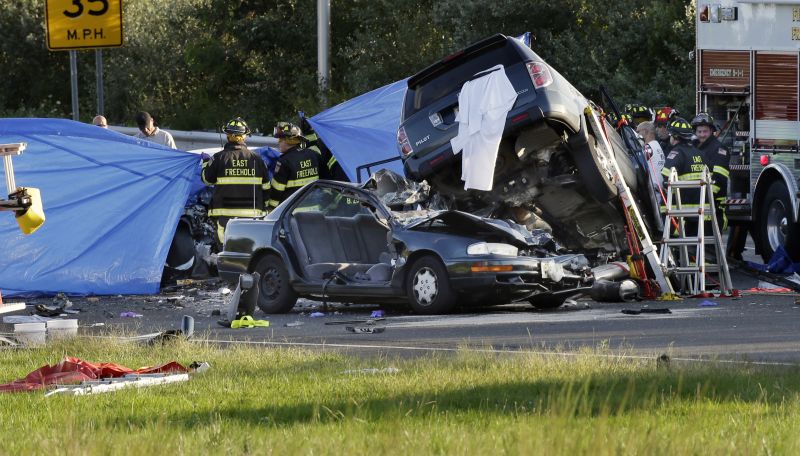
Police and firefighters work at a crash scene, Aug. 19,2014, in Freehold, N.J. Authorities say they are investigating thecrash in Freehold that left three people dead and another person incritical condition. (Photo: Mel Evans/AP Photo)
|Deaths linked to teen drivers
“Nearly two-thirds of people injured or killed in crashes involvinga teen driver are people other than the teen themselves,” accordingto Ryan. “This shows that teen drivers can be a risk toeveryone on the road and it is important to regulate their actionswhen behind the wheel.”
Over the past five years during the summer 100 DeadliestDays:
- An average of 1,022 people died each year in crashes involvingteen drivers.
- The average number of deaths from crashes involving teendrivers ages 16-19 increased by 16% per day compared to other daysof the year.
Related: Best used vehicles for teens
||||Educational resources for parents and teens
The website TeenDriving.AAA.com offers a variety of tools tohelp prepare parents and teens for the dangerous summer drivingseason. A few tips include:
- Don't ride with teen drivers or transport other teens while anew driver. One of the most dangerous sources of distraction forteen drivers, whether due to horseplay, loud music, rowdy behavioror peer pressure, is teen passengers.
- Minimize various potential distractions, such as eating,drinking, chatting with a passenger, reading a map, personalgrooming, reaching for things in the car or looking at people orobjects unrelated to the driving task.
- Don't allow a cell phone to be used in the vehicle by youor your teen.
Below is an infographic from the AAA Foundation to share withclients, family and friends.
||(Source: AAA Foundation for Traffic Safety)
Want to continue reading?
Become a Free PropertyCasualty360 Digital Reader
Your access to unlimited PropertyCasualty360 content isn’t changing.
Once you are an ALM digital member, you’ll receive:
- All PropertyCasualty360.com news coverage, best practices, and in-depth analysis.
- Educational webcasts, resources from industry leaders, and informative newsletters.
- Other award-winning websites including BenefitsPRO.com and ThinkAdvisor.com.
Already have an account? Sign In
© 2024 ALM Global, LLC, All Rights Reserved. Request academic re-use from www.copyright.com. All other uses, submit a request to [email protected]. For more information visit Asset & Logo Licensing.


